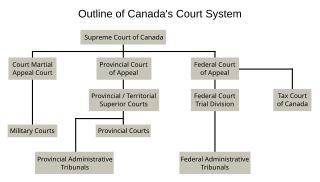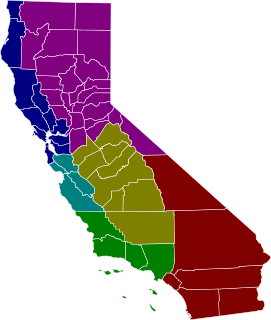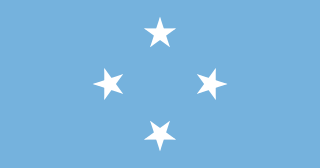
The politics of the Federated States of Micronesia (FSM) takes place in a framework of a federal representative democratic republic. The President of the Federated States of Micronesia is both head of state and head of government. Executive power is exercised by the president and his cabinet, while legislative power is vested in both the president and the Congress. The judiciary is independent of the executive and the legislature.
Jurisdiction is the practical authority granted to a legal body to administer justice within a defined field of responsibility, e.g., Michigan tax law. In federations like the United States, areas of jurisdiction apply to local, state, and federal levels; e.g. the court has jurisdiction to apply federal law.
In the United States, a state supreme court is the ultimate judicial tribunal in the court system of a particular state. On matters of state law, the decisions of a state supreme court are considered final and binding on state and even United States federal courts.

In the United States, a state court has jurisdiction over disputes with some connection to a U.S. state. State courts handle the vast majority of civil and criminal cases in the United States; the much smaller in case load and personnel, United States federal courts, handle different types of cases.
The Supreme Court of the State of New York is the trial-level court of general jurisdiction in the New York State Unified Court System. It is vested with unlimited civil and criminal jurisdiction, although outside New York City it acts primarily as a court of civil jurisdiction, with most criminal matters handled in County Court.
Associate justice or associate judge is the title for a member of a judicial panel who is not the chief justice in some jurisdictions. The title "Associate Justice" is used for members of the Supreme Court of the United States and some state supreme courts, and for some other courts in Commonwealth of Nations countries, as well as for members of the Supreme Court of the Federated States of Micronesia, a former United States Trust Territory. In other common law jurisdictions, the equivalent position is called "Puisne Justice".
The original jurisdiction of a court is the power to hear a case for the first time, as opposed to appellate jurisdiction, when a higher court has the power to review a lower court's decision. Original jurisdiction refers to the right of the Supreme court to hear a case for the first time. It has the exclusive right to hear all cases that deal with disputes between states, or between states and the union government. It also has original jurisdiction over cases brought to the court by ordinary people regarding issues to the importance of society at large.

The Judiciary Act of 1789 was a United States federal statute adopted on September 24, 1789, in the first session of the First United States Congress. It established the federal judiciary of the United States. Article III, Section 1 of the Constitution prescribed that the "judicial power of the United States, shall be vested in one supreme Court, and such inferior Courts" as Congress saw fit to establish. It made no provision for the composition or procedures of any of the courts, leaving this to Congress to decide.

The Hawaiʻi State Judiciary is the official name of the judicial system of Hawaiʻi in the United States. Based in Honolulu, the Hawaiʻi State Judiciary is a unified state court system that functions under the Chief Justice of the Hawaiʻi State Supreme Court who is its administrator-in-chief.

The court system of Canada forms the judicial branch of government, formally known as "the Queen on the Bench", which interprets the law and is made up of many courts differing in levels of legal superiority and separated by jurisdiction. Some of the courts are federal in nature, while others are provincial or territorial.

The federal judiciary of the United States is one of the three branches of the federal government of the United States organized under the United States Constitution and laws of the federal government. Article III of the Constitution requires the establishment of a Supreme Court and permits the Congress to create other federal courts, and place limitations on their jurisdiction. Article III federal judges are appointed by the President with the consent of the Senate to serve until they resign, are impeached and convicted, retire, or die.

The Supreme Court of Tasmania is the highest State court in the Australian State of Tasmania. In the Australian court hierarchy, the Supreme Court of Tasmania is in the middle level, with both an appellate jurisdiction over lower courts, and decisions made by Court to be heard on appeal by the High Court of Australia.

The California courts of appeal are the state intermediate appellate courts in the U.S. state of California. The state is geographically divided into six appellate districts. The courts of appeal form the largest state-level intermediate appellate court system in the United States, with 105 justices.

The law of Brazil is based on statutes and, partly and more recently, a mechanism called súmulas vinculantes. It derives mainly from the civil law systems of European countries, particularly Portugal, the Napoleonic Code and the Germanic law.
The supreme court is the highest court within the hierarchy of courts in many legal jurisdictions. Other descriptions for such courts include court of last resort, apex court, and highcourt of appeal. Broadly speaking, the decisions of a supreme court are not subject to further review by any other court. Supreme courts typically function primarily as appellate courts, hearing appeals from decisions of lower trial courts, or from intermediate-level appellate courts.

The Supreme Court of Palau is the highest court of Palau. Article X of the Constitution vests the Supreme Court with judicial power and provides for its operation and jurisdiction. The Supreme Court is divided into a Trial Division and an Appellate Division. Cases are adjudicated by a single justice in the Trial Division and appeals are heard by panels of three different justices in the Appellate Division. The Trial Division of the Supreme Court has jurisdiction over all civil matters over $10,000 and criminal matters not assigned to the Court of Common Pleas and adjudication of land interests. The Supreme Court also handles disciplinary and other special proceedings. The Supreme Court comprises a Chief Justice, Arthur Ngiraklsong, and three Associate Justices, Kathleen M. Salii, M. Lourdes Materne, and R. Ashby Pate. Other judges are invited to sit on an as-needed basis as Associate Justices Pro Tem or Part-Time Associate Justices.

Parliamentary elections were held in the Federated States of Micronesia on 8 March 2005, alongside a three-part referendum. As no political parties existed, all 23 candidates for the 10 available seats in Congress ran as Independents.
The Judiciary of Vermont is the state court system of Vermont, charged with Vermont law.

The Judiciary of New York is the judicial branch of the Government of New York, comprising all the courts of the State of New York

The Supreme Court of Mississippi is the highest court in the state of Mississippi. It was created in the first constitution of the state following its admission as a State of the Union in 1817. Initially it was known as the "High Court of Errors and Appeals." The court is an appellate court, as opposed to a trial court. The Court Building is located in downtown Jackson, Mississippi, the state capital.












